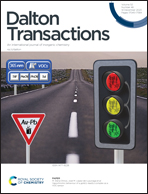Experimental and theoretical insights into palladium-mediated polymerization of para-N,N-disubstituted aminostyrene†
Abstract
Experimental and theoretical insights into polymerization of para-N,N-disubstituted aminostyrene monomers (St-4-NR2, R = Me, Et, Ph) using cationic α-diimine palladium complexes have been initially reported. The effects of the catalyst structure and monomer substituent were studied systematically. Polymerization turnover frequency (TOF) was shown to decrease in the order of monomer substituents Me > Et > Ph, whereas the molecular weight of the produced polymers showed an opposite trend (Me < Et < Ph). Methanol-mediated polymerization of para-N,N-dimethylaminostyrene (DMAS), along with polymer chain-end analysis, and palladium intermediate isolation proved that palladium-initiated DMAS polymerization obeyed a cationic mechanism. Comprehensive theoretical calculations further revealed that the carbocation was generated from the insertion of DMAS into the palladium center rather than the polarization of the methyl palladium intermediate with a coordinated DMAS. The produced amine-functionalized amorphous polystyrenes have low stereoregularity and exhibit good hydrophilic properties. The poly(para-N,N-disphenylaminostyrene) is a luminescent polymer and shows fluorescence properties, rendering this material a promising candidate for versatile potential applications.



 Please wait while we load your content...
Please wait while we load your content...